
BILL'S
[Somewhat] WEEKLY COLUMN/BLOG PAGE

IN TODAY'S RACING WORLD YOU
CAN'T MATCH THESE STORIES
In today's racing world, I am absolutely certain that the competitors love the sport just as much as they did back in the early days of stock car racing [when they actually HAD stock cars]. Furthermore, I am sure some crazy things happen, especially with the amount of travel that the sport calls for today, given the shrinking availability of tracks. But the basic primitive nature of earlier racing just gives rise to some of the damnedest stories you'd ever want to hear.
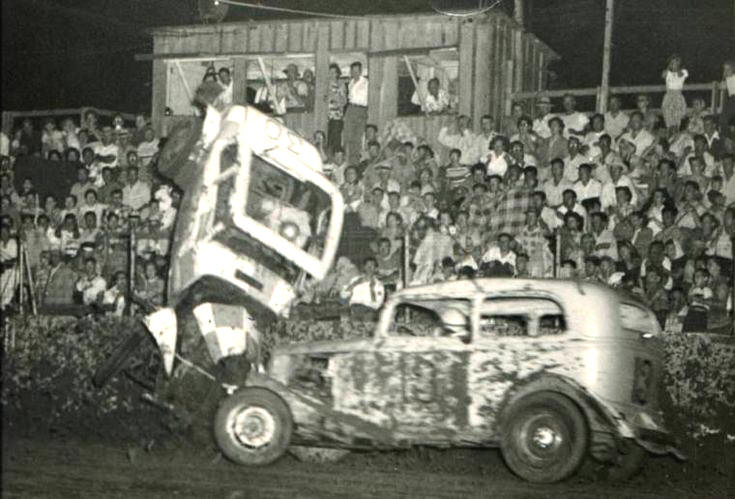
From Pinterest
With the high tech world of early racing anything
could happen
[and usually did].
When I can trap certain guys for a decent conversation, I get some of the most outrageous stories from the 1950's or maybe early '60's [some of them might even be true]. Take, for instance 1961 NASCAR National Sportsman co – champion Dick Nephew, from remote Mooers Forks, NY. A burly man with a heavy French accent, Nephew found time from his excavating business to travel widely in search of places to race. [That is, by the way, the only way you're going to accrue enough points for a national title].
Nephew often ventured into Canada, where he could speak fluently in their native Quecois and where he most likely mingled among many relatives. Son, Gary tells of the time they were racing at one of the NASCAR – sanctioned tracks in the immediate Montreal area when his famous red #6 broke down and couldn't be quickly fixed. After very little thought, Nephew ran out to where his Cadillac sat, having towed the 6 to the track. He entered the Caddy in the feature. There are no details about dents or results.
Nephew Family Photo
Dick stands in Victory Lane at AIrborne Park
Speedway
with famed starter Art Prairie Lane, Below - Dick, in a Canadian
Victory Lane with both sons. Hopefully, the
Caddy was intact enough to get everybody home.
Courtesy of Gary Nephew
The racing Hackel family goes back four generations, to the late 1940's – when, In NY, they were going through roadster racing phase. The alarmingly dangerous, roofless hot rods might have seat belts if you were lucky but that's about all. Buzz Hackel, the patriarch of the family, was running a car dealership in or around Albany when he had a guy come in who wanted to buy an old roadster the elder Hackel had on the lot.
The idea was that Buzz would assist the customer in stripping the few unnecessary parts still left on the car and generally get it ready to race for the guy. They were to meet at the Burden Lake race track that Sunday for the guy to race. Well, he never showed up and Buzz never saw him again. Maybe one look at Burden Lake Speedway was enough to dissuade the guy. It was a long oiled track that went uphill in one direction and downhill on the other straightaway.
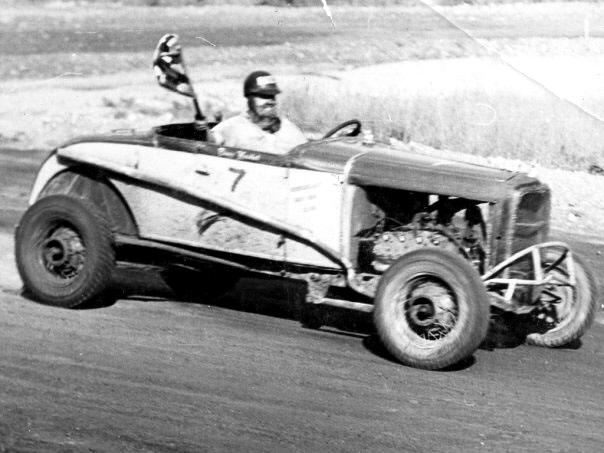
Hackel Racing Site Photo
Buzz Hackel tools along, maybe in that first
roadster he
“inherited” at Burden Lake. Below – Hackel [right]
with Howie Westervelt, another NY racing legend.
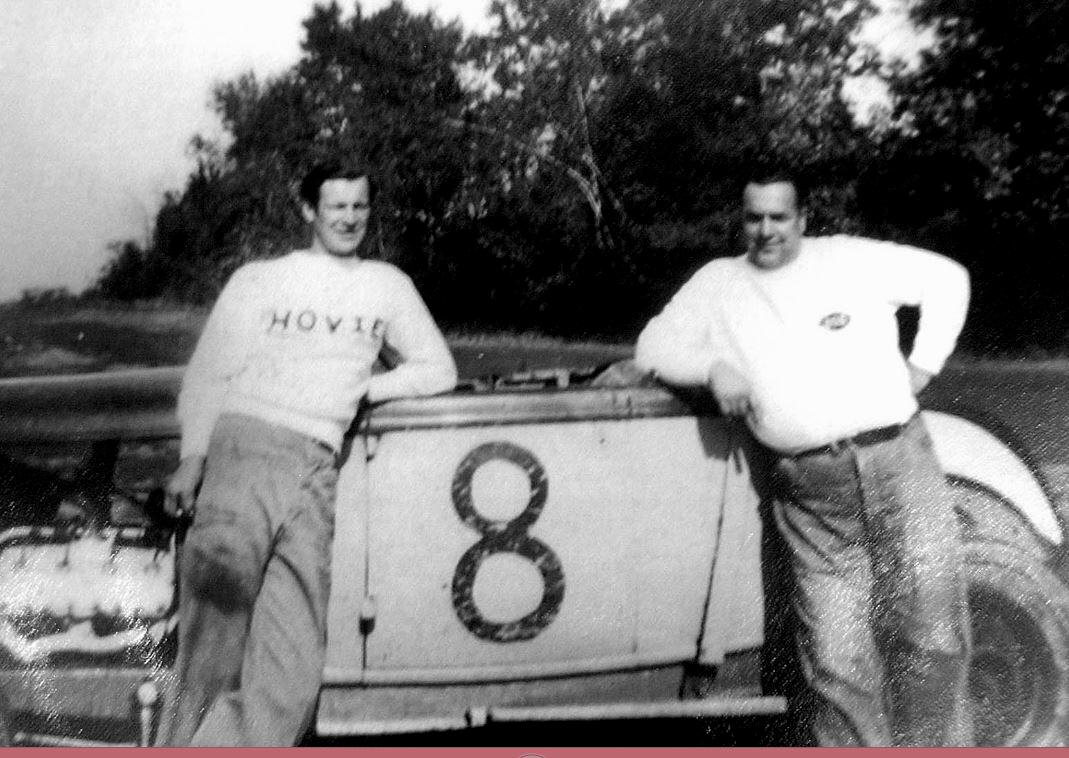
Courtesy of Ken Gypson
Hackel ended up taking the roaster and driving it himself. It worked out, as he was somewhat celebrated as an early driver, running against the likes of an equally – young Howie Westervelt, Del Moak [wrenched by Cliff Wright], and others. Hackel would later have a stock car coupe #77 which he drove and which he fielded for drivers such as Lee Palmer. Of course, son Bob made his mark as a driver and builder and mini modifieds and now great grandson Bobby is now a star.
Publisher and former driver Lew “Batman” Boyd tells a story of deciding he was going to graduate from his Bomber and Hobby division racing around Massachusetts, setting his eyes on a major race at one of the NY/PA/NJ tracks. He bought what he described as “a low level modified from someone” and headed out to a qualifier among the gods. He found himself at the tail end of large heat alongside the great Frankie Schneider, one of his idols.

Courtesy of R.A. Silvia via Dave Dykes
Lew “Batman” Boyd had not come from a background
of powerful modifieds. Below – Frankie Schneider said
[in so many words] “Learn to drive , boy”.

Courtesy of Dave Dykes
As the field began to pick up speed, perhaps one lap or so before the green fell, Lew managed to spin the unfamiliar car out. Doubtless, he was not used to the power the car had after driving in support classes. As Lew pulled back up to catch the field, Schneider looked over at him and shook his head in disgust. How that qualifer turned out was immaterial to Lew's story.
After the race in a conversation Boyd told Frankie he had broken his heart, having been dismissed by the great Frankie Schneider. In ensuing give – and – take, Frankie asked Boyd where he was from. Lew replied he was from Boston.
“Never heard of it!”, was Schneider's reply.

Courtesy of LaBreche Family
Crewmen work on the Beliveau B45, a familiar
Quebec
team. [Watch where you lay down, Mon Ami]. Below - Here is
a Canadian mechanic actually working under a car
at Bouvrette Speedway, St. Jerome.
Courtesy of LaBreche Family
I got to talking to Canadian named Albert Hassal, one night over at Airborne Speedway. He mentioned that the bulk of his race track experience was with track cleanup and safety crews. Being from Canada, he had some fairly interesting stories, as early Canadian tracks did not make safety a high priority. Hassal tells of one of his safety team noticing a car exiting the track into the pits. Another team had chosen a particularly dumb place to stop and work on the car.
The exiting car was heading on a path to run over the lower body of a crewman [whom he couldn't see] working under the dumb car. The safety man grabbed the guy's legs and yanked him out, which happened to be through a mud puddle. Enraged, the crewman slugged Hassal's man. When it was finally obvious what had transpired, that safety crew member did not have to buy another beer for a year, if the grateful mechanic was around.
Courtesy of the Owen Family
Despite its hairy atmosphere, Noel Speedway
attracted American
stars such as Vermont' Gordy Owen [above] and Keene, NH's
Roy “Pappy” Forsyth [note the tee shirt].
Courtesy of Walt Perkins
At Noel raceway, Brassard, Quebec, races would start not too long after church services were over. One of the drivers apparently came straight from church and was still wearing his best dress suit. No time to change. Naturally, it would be that driver who flipped his car on the “terre batteau” [dirt track]. He, too ended up getting pulled out of the car and into a mud puddle. Albert says half the track crew was feeling around in the puddle for the guy's wallet.
At that same Noel Raceway, named after the owner, they ahd some pretty flaky people driving race cars. One particular local nut case was driving around with obvious mechanical issues; so, he got the black flag. Incensed, he spun the car around in the middle of the and proceeded to aim for the flag stand, where the poor flagger was trying to climb the fence to get away. Other stock cars had to corner him and wreck him to get him under control.
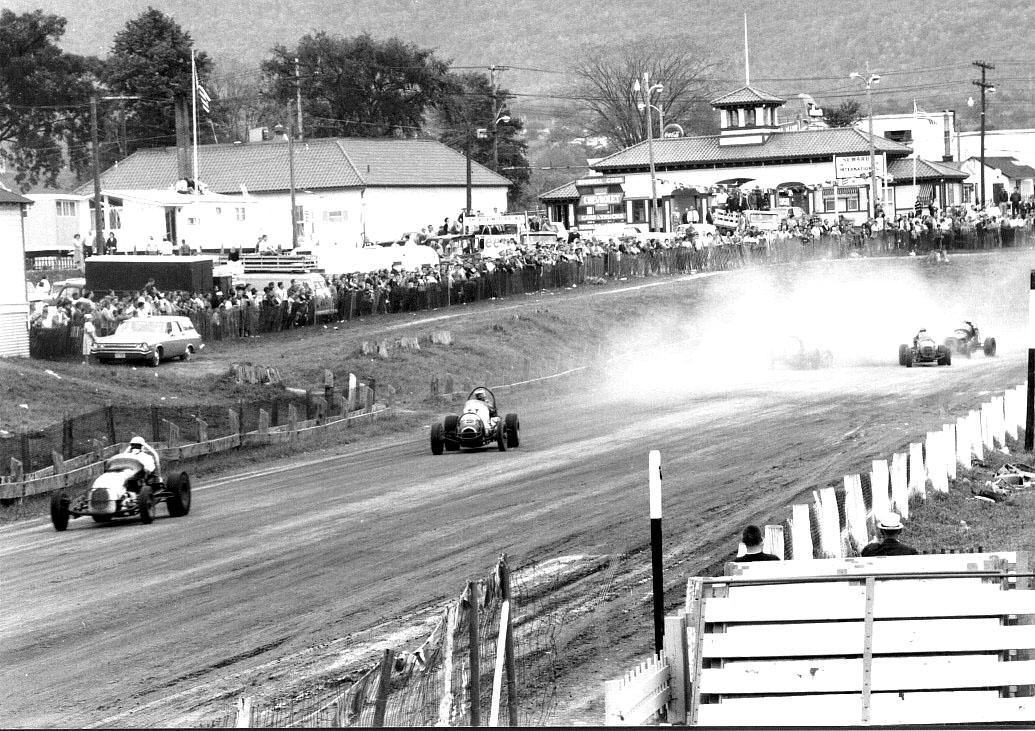
Courtesy of Cho Lee
Sprint cars tangle in dusty conditions at the
Vermont State
Fair in Rutland around 1963. Billy McDonald was in that
program. Below - September, 1962 - Champlain Valley Exposition.
Billy was pretty good at wrecking open wheel cars.

Burlington Free Press Photo
Early tracks were notorious for dust problems because most ran on a Sunday afternoon and the primitive water trucks [which probably started watering an hour before the races] couldn't keep up with the effects of the sun. Faster cars like sprinters were particularly susceptible to problems of poor visibility. Milton, Vermont native Billy McDonald [never exactly a racing standout] is central to two of these stories. In one case, McDonald was driving at some rinky dink track one Sunday afternoon. Kenny Gallup, a well – know New York driver, was about to lap him McDonald, while mostly deaf, could see as well an anyone else except in the dense, peasoupy dust, accidentally clipped the passing Gallup and flipped him, breaking a shoulder.
In another case, McDonald had taken the sprinter all the way from northern Vermont down to the Rhythm Inn Speedway in Millers Falls, Massachusetts [not too far from the Vermont border]. The track, which got its name from a strip joint on the same grounds, was no different than any other early '50's track – dustier than hell. McDonald told whoever he brought to drive the car, to count a certain number of fences posts and then turn right because they couldn't much out there.
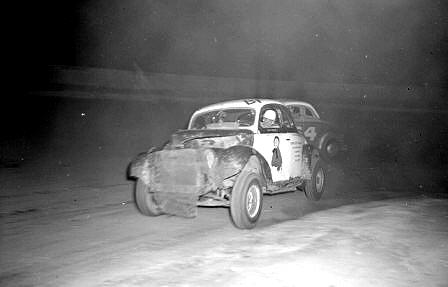
From Racers Bored Chat Site
The Springfield, MA Ray Brown in action at Rhythm
Inn Speedway.
Below – A field of cars comes out of turn four in a haze of dust in a Sunday
afternoon program at Rutland's short – lived Pico Raceway [not more than a
mile south of the aforementioned fairgrounds].
From Dan Ody's 8MM Old Speedways DVD's
The McDonald car ended up cutting through the infield and was summarily black flagged. When Billy got to the car he asked the guy what the hell he was doing, cutting through the crowded infield pits like that. The guy said he remembered to count, like he was told – but he must have “counted too fast”.
Imagine getting away with this today. If you don't live anywhere near Canada, ike I do, let me assure you it has not been simple to cross the border in either direction since 9/11. Now, there are many references in the history of Catamount Stadium about the infamous tree house that sat, not far off turn one, on the Sibley family property. The Sibley boys had constructed it just to watch the action at the track. Several errant tires and one errant modified with a stuck throttle added excitement to the tree house denizens in the earliest season of the track.
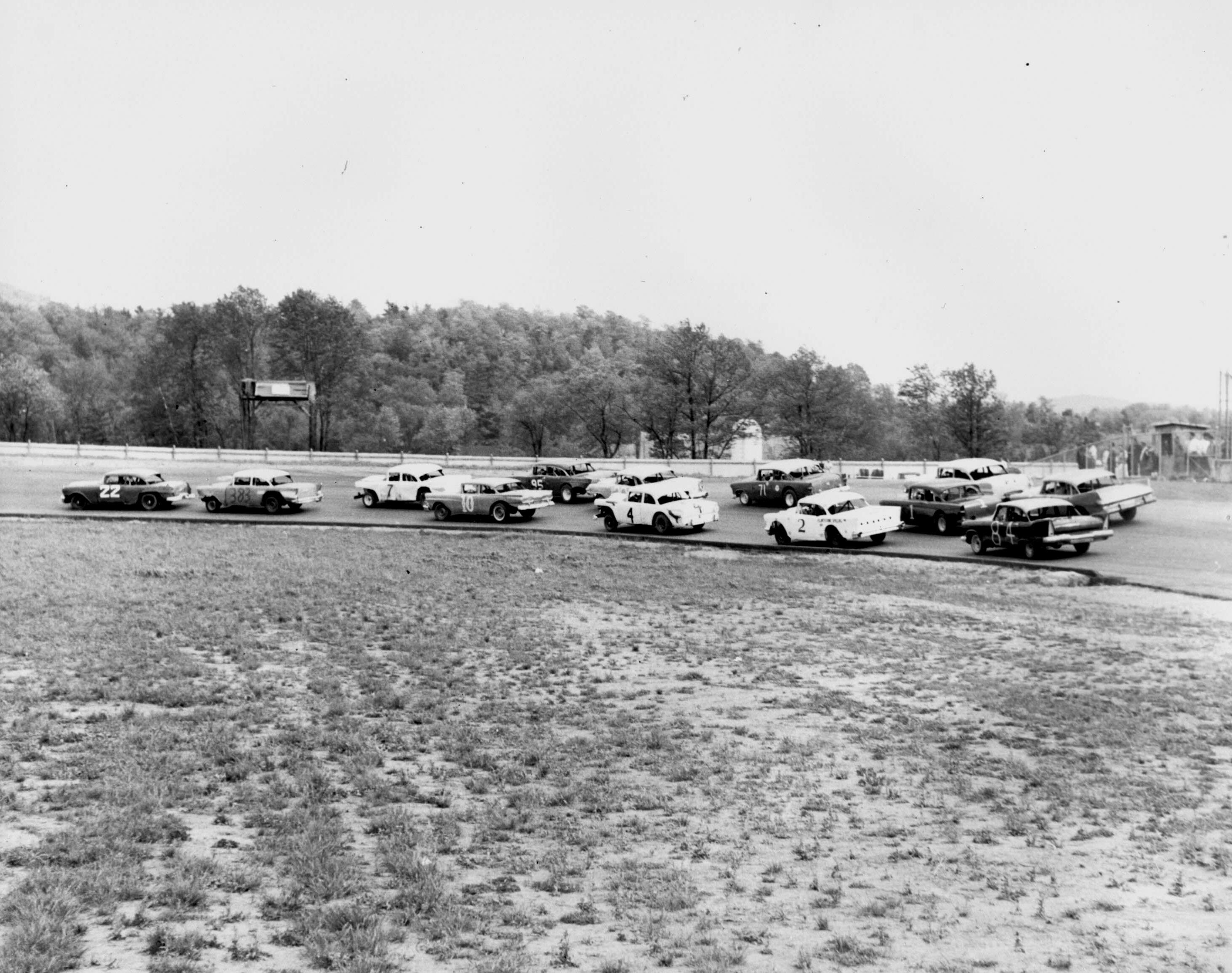
Courtesy of Cho Lee
An early field of Flying Tigers starts their
feature as the
Infamous Sibley tree house looms in the tree above. Below -
The American border station at Highgate Springs. This
was easy for Ron Sibley; it was the Canadian station where
he sweated it out every week.

Source Unknown
Finally according to Ken Squier, the insurance company told him either the tree house goes or we won't insure you any longer. What could he do ? He offered the Sibleys jobs at the track and they agreed to stay out of the tree house on race nights. Ron Sibley eventually ended up with the job of taking the Saturday night proceeds to the banks. The Burlington banks and the American money was easy enough: count the dough, pack it in garbage bags, and take it the Merchants Bank.
The Canadian money was another thing altogether. You could only bring $10,000 across the border at any one given time. The great Canadian driver Jean – Paul Cabana once told me that anywhere from 45 to 55% of the Catamount crowd was Canadian. So, between concessions and admission, that was a lot of loonies. Ron says he would take a very unimpressive old pickup truck, head up to the Highgate border crossing station, and declare the $10,000 every week. Seeing as there was between $20 and $30,000 Canadian dollars each week, that was quite a trick. The rest of the money ? It sat in a rusty old toolbox, out in plain sight in the back of the pickup. Try that today !

Source Unknown
It might have just been more fun back then. 1950,
Autodrome
Ste-Monique, QU: Driver Gaston Guay, wife, and friends
relax before a nice dusty afternoon of early racing.
There are about as many of these anecdotal stories as there are old race results. It definitely had to be more fun then – as long as you lived through it in one piece.
Please email me at wladabou@comcast.net if you have any photos to lend me or information and corrections I could benefit from. Please do not submit anything you are not willing to allow me to use on my website - and thanks. For those who still don’t like computers - my regular address is: Bill Ladabouche, 23 York Street, Swanton, Vermont 05488.
AS ALWAYS, DON’T FORGET TO CHECK OUT THE
REST OF MY WEBSITE:
www.catamountstadium.com
Return to the Main Page
Return to the Main News Page
Return to the All Links Page
Return to the Weekly Blog Links Page